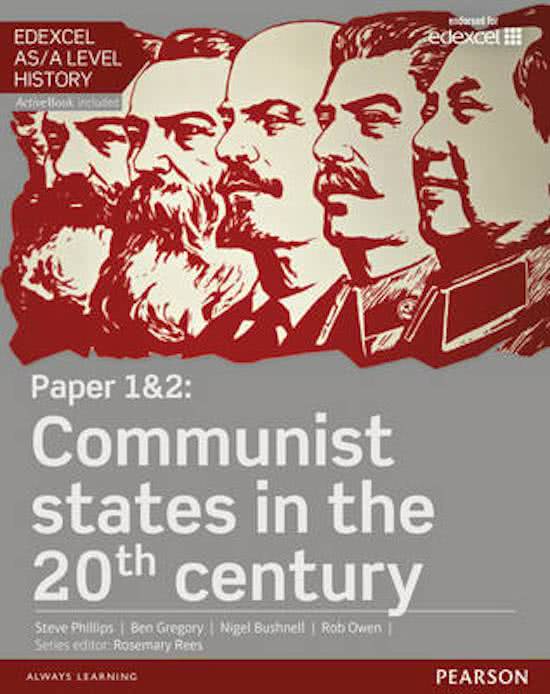Social developments, 1917-85
How successful was the government in providing social security for the Soviet people
between 1917 and 1985
- One of the greatest attractions of communism was its claim that it would ensure that the
people were provided with what they needed; this included the provision of employment,
shelter, food, an education and welfare such as healthcare
Full employment, housing and social benefits, 1917-53
The labour market under Lenin
- The collapse of industrial production during the civil war of 1918-21 resulted in a drift of
factory workers to the countryside where food supplies were more reliable
- This led factories to have insufficient workers and the government resorted to issuing a
decree that forced people without employment to take any work offered
- The end of the civil war brought additional pressures to the labour market
o Demobilisation of the Red Mary returned millions of soldiers to the cities in search of
work and food
o Unemployment soared and reached over 1 million workers by 1926
o For skilled workers there was increasing job security
- Impact of the NEP
o Wage differentials grew as skilled workers demanded more money than their
unskilled counterparts
Industrialisation and full employment
- The Soviet government could hardly claim that the five year plans were launched to create
full employment
- In 1930, the soviet government announced that it was the first county to reach full
employment in peace time
o Number of hired workers rose from 11.6 million in 1928 to 27million in 1937
o Employment opportunities were plentiful with the rapid expansion in heavy industry
- By 1932, there were labour shortages
- Full employment had a considerable impact on the workers
o In October 1930, unemployment benefit was cancelled in the light of full
employment
o Productivity was low, in 1938, the average soviet worker produced only half of what
a British worker produced
o Most of the work was hard, repetitive and unchallenging increasing absenteeism
o High employment turnover
In order to deal with this, the government introduced a passport system in
1932
Only partly successful, 30% of all urban workers changed their job in each
quarter of the year
o In 1931, wages for skilled workers increased to discourage them from moving jobs
The following year better rations and bonuses were introduced to add
incentive
o The government used honours and medals to motivate the workforce
A key example is like Alexei Stakhanov who could apparently mine 15x the
average amount of coal
Housing
- Soviet government was slow to make an impact on the provision oh housing for its
population
, - In 1917, the Bolsheviks began a programme of confiscating the large houses of the rich and
portioning them and renting them to families of workers
o The principle of allocating housing according to need was often dropped in favour of
distribution according to rank within communist party
o The reality was that there was not enough hosing to meet the needs of all
- The growth of towns and industrial centres under the five year plans put considerable strain
on housing
o Housing revived few resources, was low priority, despite the focus on
industrialisation greatly increased the demand for workers housing
o Established cities saw exceptional growth eg Moscows’ population increased from
2.2 million in 1929 to 4.1 million in 1936
o The population of Magnitogorsk rose from 25 people in 1929 to 250,000 in 1932
- The rush to industrialise often left workers sleeping in tents and makeshift housing
- Conditions did improve throughout the 1930s but often were only drab barracks or blocks of
apartments where resources would allow
- In 1936, only 6% of rented units of housing consisted of more than one room
o 24% of cases it was only part of one room
o 5% of people lived in a kitchen or a corridor
- The lack of available housing was exacerbated by the damage caused during the WWII
o Some cities were particularly badly hit, Stalingrad lost 90% of its hosing and
Leningrad lost lone-third during the siege of the city
- Housing remained low priority in the fourth and fifth five year plans where post
reconstruction was heavily focused on heavy industry
Social benefits
- The workplace did provide some social benefits; by the 1930s, cheap food was available
within the workforce canteens and work clothes were given free
- Despite the trade unions losing the majority of their economic and political power, they
played a key role in organising sports facilities, meetings and film shows
o Workers were give 2 weeks paid holiday – this was usually taken on cheap subsidised
state resorts
o Trade unions were responsible for organising these and sick pay was also granted
through trade unions
- Health care was designed by the government to benefit all the population and despite
limited resources, it proved effective at containing epidemics
o A compulsory vaccine was implemented in 1921 to deal with a serious cholera
outbreak
- Many doctors had fled Russian soon after the revolution and this weakened health care
provision
o The government was forced to increase the number of training places on offer
o As a result, the number of doctors increased from 70,000 in 1928 to 155,000 in 1940
o The number of hospital beds increased 247,000 in 1928 to 791,000 in 1939
This does not necessarily mean the quality was amazing but does show that
there were considerable improvements
Khrushchev, Brezhnev and the promotion of a stable society, 1953-85
- Society became much more stable under Khrushchev and Brezhnev
What were the key features of social stability under developed socialism
Full employment





